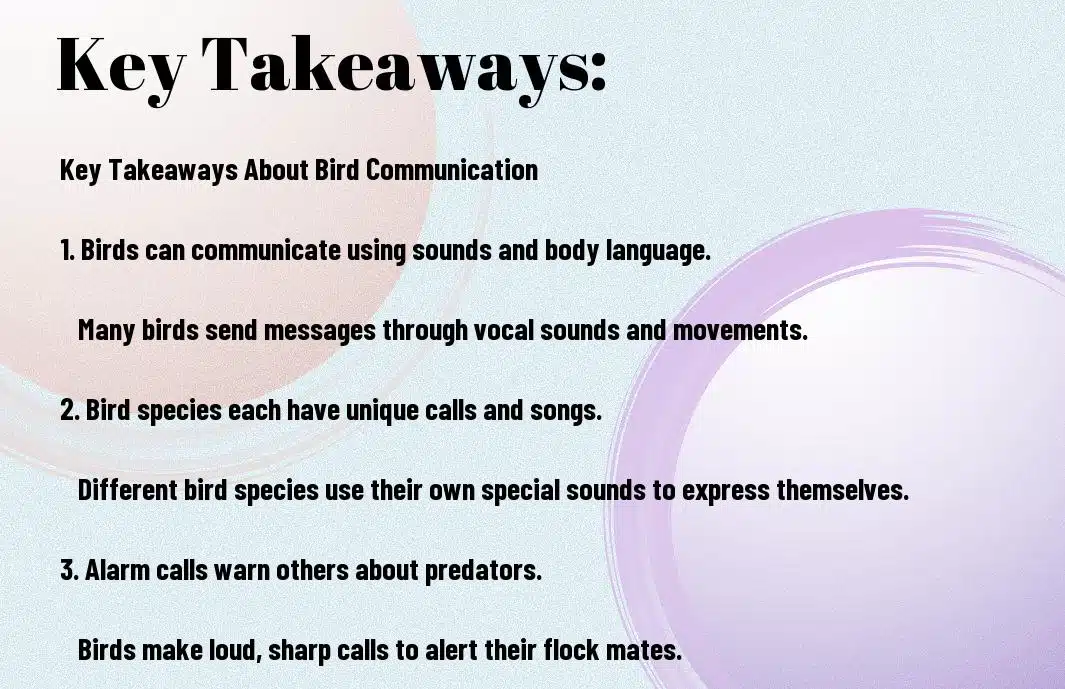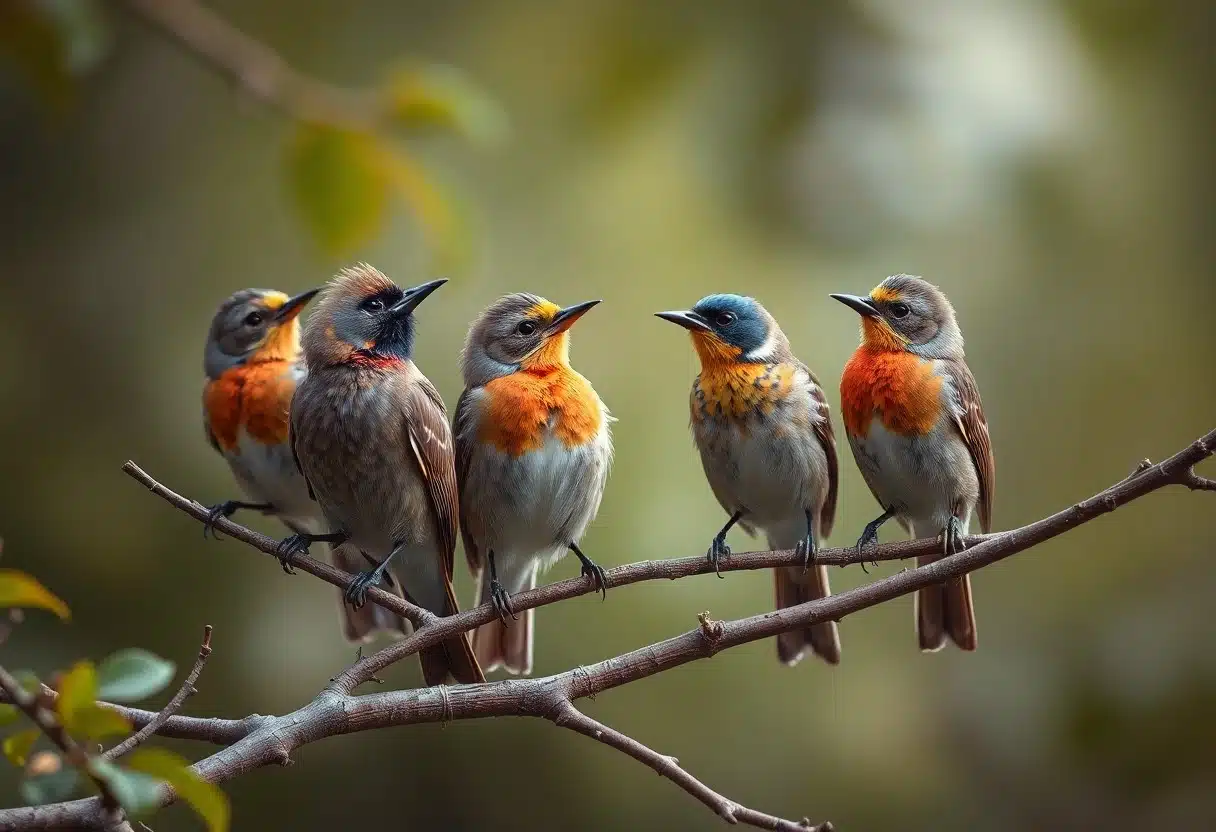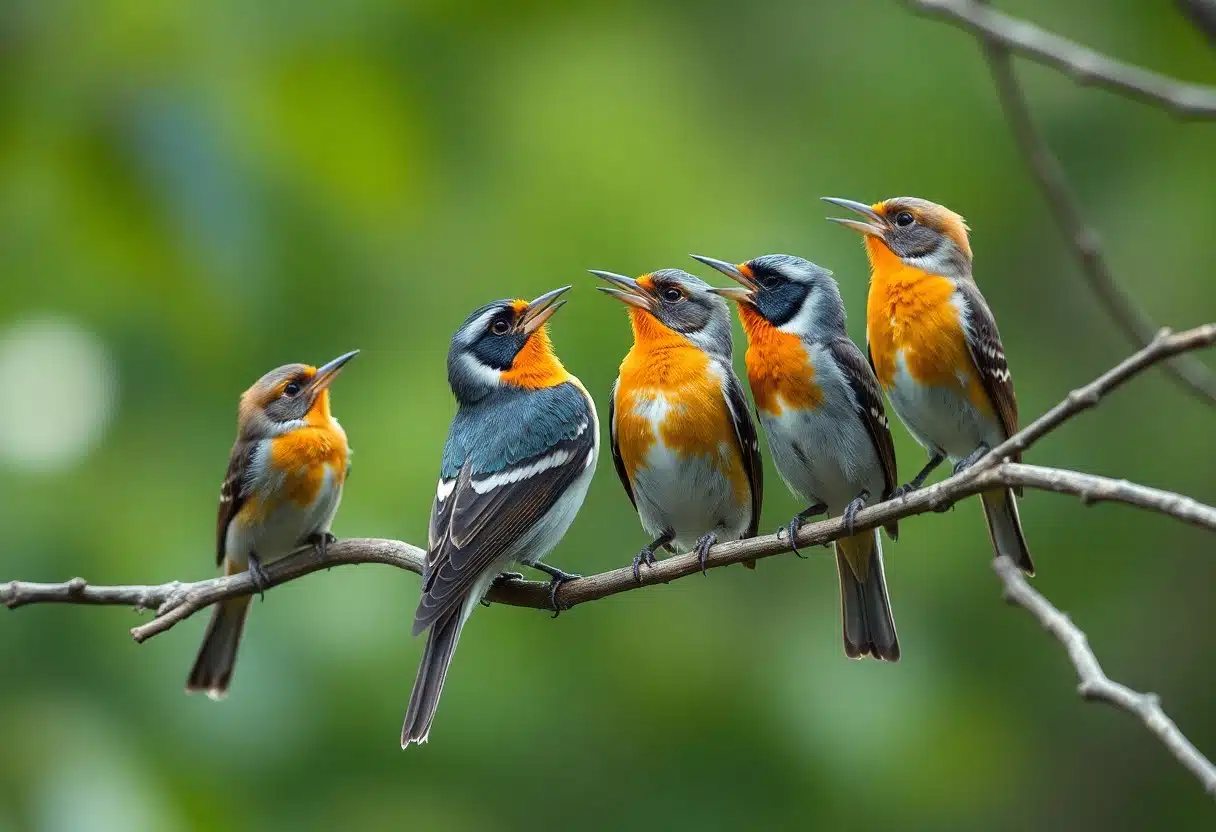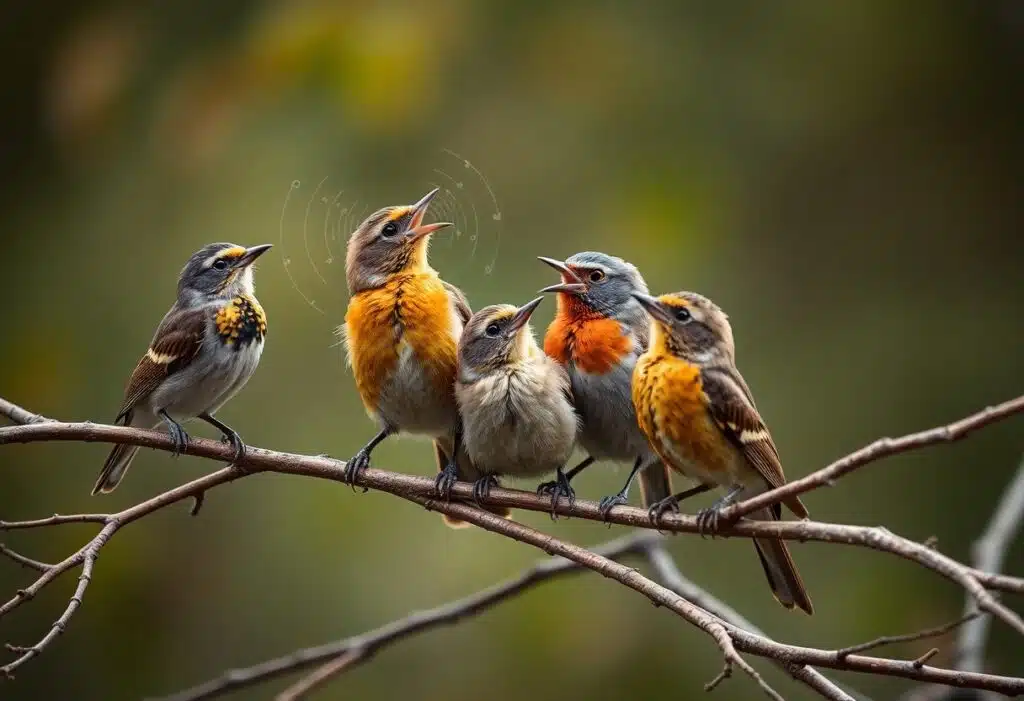Can Birds Communicate?
It’s truly amazing how birds communicate with each other! You may have seen videos of parrots mimicking human speech, but there’s so much more to the fascinating world of bird communication. Birds use Vocalizations are a crucial part of how birds communicate, with many species using a variety of sounds to convey messages. like songs and calls, as well as body language and visual displays to send messages. From alerting flock mates of nearby predators to performing elaborate courtship dances, birds have developed unique ways to interact within their species. Join us as we probe the intricate ways birds communicate and what these behaviors reveal about their lives!
Key Takeaways:
- Birds Can Communicate: They use both sounds and actions to share messages with each other. Different species have their own ways of communicating, and they can mix calls and songs to fit the situation.
- Vocalization Matters: Birds make various sounds, like alarm calls to warn nearby birds about predators, and sweet songs during courtship to attract mates. Baby birds also learn these calls from their parents to stay in touch.
- Body Language is Key: Birds don’t only use sounds; they also communicate using their colors and movements. For instance, bright plumage helps attract mates, while postures like puffing up their feathers can scare off rivals.
> “By studying bird communication, we gain a deeper understanding of how they live, interact, and thrive in their environments.” Understanding the intricate methods birds use to communicate is a fascinating part of nature. Whether it’s a vibrant male bird trying to impress a mate or a parent calling out to its chick, there’s always something interesting happening in the avian world. All these different bird sounds and behaviors work together in a beautiful language of their own, helping them survive and connect with each other.

Overview of Bird Communication
To truly appreciate the fascinating world of bird communication, it’s important to recognize that birds use a variety of methods to interact not just with each other but also with their environment. Birds communicate through sounds, such as songs and calls, as well as intricate body language and visual displays. These different forms of communication help birds signal alarm, defend their territories, find food, and engage in courtship, ensuring their survival and the well-being of their species.
Complexity of Bird Communication
Complexity is a key feature of bird communication, as many bird species can produce a remarkable range of sounds. For example, the Nightingale can create over a thousand distinct tunes. These different vocalizations serve specific purposes, such as attracting mates or warning others about nearby predators. Understanding this complexity can give you amazing insights into the behavior and communication strategies of different birds.
Visual Clues in Bird Communication
Any birdwatcher knows that communication isn’t solely about vocal sounds; visual cues play a significant role too. Many birds use their plumage, postures, and movements to convey messages to potential mates or rivals. For example, a male bird may use bright colors and elaborate displays during courtship to attract a female, while aggressive birds may puff up or bob their heads to appear larger to intimidate threats or other birds.
Communication between birds is not just through their beaks but also through body language. Movements like wing flapping or crest-raising can indicate various emotions or intentions, such as courting or defending a territory. You might notice that during breeding season, many male birds flaunt their brightest plumage to catch the eye of nearby females. These visual signals are just as important as their calls and songs, helping birds establish their presence and status within their natural habitat.
The Significance of Studying Bird Communication
Now, understanding how birds communicate reveals their fascinating world. It shines a light on their survival skills and social interactions. By studying different species, we learn how birds defend their territories, find food sources, and keep in touch with flock mates. This knowledge enriches your appreciation of the complex lives of birds and the roles they play in ecosystems.
Understanding Survival and Interaction
On your journey to understand bird communication, you’ll discover how these creatures signal alarm, court mates, and stay in contact with each other. Alarm calls can alert nearby birds to a predator, while melodious songs are used during courtship. These vocalizations are key to helping birds survive and interact with one another.
Role in Ecosystems and Conservation
Birds play vital roles in their ecosystems, and what they communicate helps maintain the balance of nature. Understanding how they communicate allows you to see their influence on their habitats. Strong communication skills help them find food, attract mates, and navigate their environments.
Understanding how birds communicate connects strongly to their roles in ecosystems. They help with pollination, seed dispersal, and controlling insect populations. When you study these interactions, you appreciate how healthy bird populations are indicators of a thriving environment. Observing how birds send messages to one another, whether through songs or body language, allows you to recognize changes in habitat health. This can be important for conservation efforts, as protecting their natural habitats means ensuring the survival of many bird species.

Defining Bird Communication
All birds have developed ways to communicate with each other that go beyond just vocalizations and mimicry. They use a variety of signals to convey messages about alarm, territorial defense, and even courtship. Understanding these different methods helps you appreciate the intricacies of bird communication and the roles that various bird species take in their environments.
Types of Communication
One way birds convey messages is through vocal communication and non-vocal signals. Their communication methods are diverse and include:
- Bird songs: Used primarily during mating.
- Bird calls: Short, quick sounds for staying in touch.
- Visual signals: Plumage and body language.
- Alarm calls: Loud sounds to warn others of danger.
- Body language: Displays to assert dominance.
Any method helps birds stay connected and safe in their world.
Evolution of Bird Communication Studies
Communication in birds has evolved through constant study and observation, helping you learn how these amazing animals interact. Understanding how birds communicate has improved with technology, giving you access to quality recordings and detailed analyses. Early methods were simple, relying on handwritten notes, but advancements have allowed researchers to decode what birds are trying to say.
Types of communication include vocal signals, visual displays, and even tactile interactions. Over time, researchers have made significant strides in understanding how birds communicate and what these interactions mean. You can observe how different species adapt their calls and songs to survive in their environment and learn to identify various signals for mating, warning, or flocking. This has yielded a deeper understanding of how birds connect with each other and navigate their natural habitats.
“Every type of call and song serves a purpose, connecting birds and allowing them to find food, warn each other of predators, and attract mates.”
To sum up, the world of bird communication is fantastic and layered, providing insights into their behaviors and interactions.

Types of Communication
Not all birds use the same methods to communicate. They employ various forms to convey messages, including:
- Vocal communication is essential for many bird species, including songbirds, to establish territory and attract mates. Songs and calls
- Visual Communication: Displaying colors and postures
- Chemical Communication: Scent signaling
- Tactile communication is an important aspect of bird behavior that allows them to interact closely with each other.: Physical interactions among wild birds often involve a combination of vocalizations and body language.
- Body Language: Non-verbal cues, such as body language, play a significant role in how birds interact with another bird.
Recognizing these different types of communication in birds enhances our understanding of their remarkable behaviors.
| Type | Description |
| Vocal Communication | Using songs and calls |
| Visual Communication | Expressing through color and posture |
| Chemical Communication | Signaling with scents |
| Tactile Communication | Physical interactions |
| Body Language | Using gestures and movements |
Vocal Communication
Communication among birds frequently happens through vocalizations. Birds use different calls and songs to share important information. Songs are often melodious and are mainly for attracting mates or marking territories, while calls are shorter sounds used to keep in contact or signal danger to the flock.
Visual Communication
With their vivid colors and distinct postures, birds also communicate through visual signals. They display their plumage, especially during courtship, showcasing their vibrant colors to attract mates and assert their dominance.
Communication through visual signals includes displaying brightly colored plumage and specific postures. Birds like peacocks use their stunning feathers to garner attention during mating rituals, while others may raise their wings or puff out their chests to appear larger and more threatening to predators or rival birds. These visual cues play a significant role in how birds interact and express themselves in their natural habitat.
Chemical and Tactile Communication
Communication through scents and touch is also vital. Birds may use odors to communicate specific messages, like identifying members of their flock. Tactile interactions, such as gentle preening, strengthen bonds between mates.
Tactile communication, such as when puffins rub their beaks together, showcases how physical contact can enhance relationships. It’s vital for building strong bonds between mates and ensuring both members of a pair are in sync. These subtle yet profound connections demonstrate the intricacies of how birds communicate beyond vocal sounds, all vital for maintaining their social structures and defending against potential threats.
Vocal Communication
Unlike human language, birds have their own unique ways to communicate through a variety of vocal sounds. Many bird species can make an impressive range of noises, which they use to send messages to each other, showcasing the diversity of bird behavior. These vocalizations include songs, calls, and alarm noises. Each type of sound has a specific purpose, allowing birds to signal everything from mating intentions to warnings about nearby predators.
Bird Songs
Bird songs play a significant role in courtship and territory defense. These melodious sounds are often used by male birds to attract potential mates and claim their territory. Different bird species express themselves in unique ways, with some like the Nightingale boasting over a thousand distinct tunes. Your knowledge of their song can help you identify different species and learn about their behaviors.
Bird Calls
Above all, bird calls are imperative for keeping in touch with flock mates and for alerting them to danger. These shorter sounds are often *loud and sharp*, making it easier for nearby birds to hear them. You may have noticed how a sudden *squawk* can send the flock into alert mode when a predator is nearby, helping them stay *safe* from harm.
Hence, understanding bird calls can deepen your appreciation for these extraordinary creatures. Calls such as alarm, contact, and distress sounds all play a role in survival. For instance, when a flock of birds is feeding, you might hear quiet contact calls that help them stay in touch without drawing attention to themselves. Alternatively, a sharp alarm call can startle intruders and warn other birds of a lurking *danger*. By recognizing these different calls, you can enhance your experience in observing birds in their natural habitat.
bird communication
Learning and Development of Vocalizations
Despite what you may think, birds do more than simply squawk at each other. They have fascinating ways of learning to communicate. Birds develop their songs and calls through a mix of genetic gifts and their social environment. This means that both nature and nurture play a role in how your feathered friends express themselves.
Genetic and Social Factors
Genetic factors give some species of birds their ability to make specific sounds as soon as they hatch. Social learning, on the other hand, allows baby birds to pick up tunes from their parents and other nearby birds. This blend of influences leads to a more vibrant bird language.
- Genetic Factors: Some birds are born knowing basic calls.
- Social Learning: Young birds listen and mimic adult calls.
- Combined Learning: This mix creates diverse vocalizations.
Knowing how these factors work helps to reveal the complexities of bird communication.
Mimicry and Imitation
Any bird lover knows that many birds are incredible mimics. They don’t just stick to their own species’ songs. Parrots and mockingbirds can pick up sounds from their environment, including human voices and other bird calls. This ability showcases their intelligence and adaptability.
Indeed, mimicry enhances a bird’s chances of survival by enabling them to mix and match different sounds. For example, a parrot might learn a human laugh, which can confuse potential predators. Plus, the more varied the sounds they can produce, the broader their communication ability. This fascinating skill allows birds to communicate not only within their species but also with different species, showcasing how animals communicate in diverse ways. As you explore the intricate world of bird communication, you’ll find that birds can send messages about food, safety, and even courtship. Each call or song reflects a dynamic interaction, providing insight into their lives and relationships.
To Wrap Up
With these considerations, you can see that birds communicate in many fascinating ways. Different bird species use sounds, body language, and colors to communicate with each other, whether to warn of predators or attract a mate, which is common for birds. By studying bird communication, you gain a deeper understanding of their behavior and how they interact within their natural habitat. Whether you’re watching robins squawk or hearing the melodious songs of nightingales, there’s always more to learn about the remarkable ways birds connect with one another. So grab a field guide and explore the sounds and sights around you!
FAQ
Q: Can birds communicate with each other?
A: Yes, birds can communicate in many ways, like using sounds, body language, and visual displays. They send messages to each other, especially about threats or during mating.
Q: How do different bird species communicate?
A: Different species use various bird calls and songs to convey messages. For example, some species may use alarm calls to warn of predators, while others might sing during courtship.
Q: How do baby birds learn to communicate?
A: Baby birds learn to communicate by mimicking the sounds and behaviors of adult birds in their nest. They pick up songs and calls from their parents and nearby birds as they grow, demonstrating how songbirds learn to communicate.
As a bird enthusiast with a passion for sharing the wonders of our feathered friends. As a writer and nature lover, I'm thrilled to connect with fellow bird buffs and inspire others to take flight into the fascinating world of birds. Let's wing it together!


